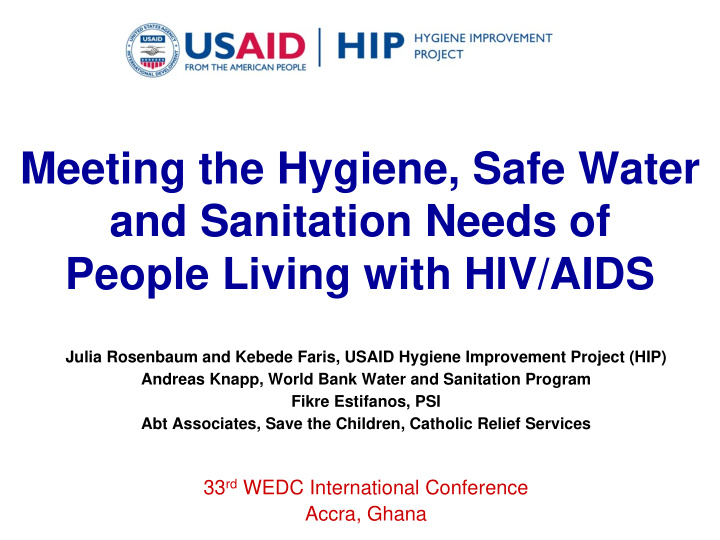



Meeting the Hygiene, Safe Water and Sanitation Needs of People Living with HIV/AIDS Julia Rosenbaum and Kebede Faris, USAID Hygiene Improvement Project (HIP) Andreas Knapp, World Bank Water and Sanitation Program Fikre Estifanos, PSI Abt Associates, Save the Children, Catholic Relief Services 33 rd WEDC International Conference Accra, Ghana
Why Water, Sanitation, and Hygiene (WASH) Matter for PLWHA • Most diarrhea is caused by unsafe water, inadequate sanitation and poor hygiene • Diarrhea affects 90% of people living with HIV and AIDS (PLWHA), causing significant morbidity and mortality • Morbidity and mortality from diarrhea more severe in HIV+ children • Diarrheal disease reduces absorption of antiretrovirals • Burden on caregivers in clinics and homes • PLWHA need more water to keep environment clean
The Evidence Base for WASH • Hygiene improvement can reduce risk of diarrhea disease (DD) for PLWHA • Hand washing with soap can reduce DD by 43% • Safe water treatment and storage at the point of use can reduce DD by 30-50% • Proper disposal of feces can reduce DD by 30% or more
HIP Promotion of Small Doable Actions in Ethiopia • Pilot to integrate WASH into home-based care for PLWHA in Amhara, Ethiopia with HIP/PSI/Abt • Training and capacity building for home-based care workers • Trials of Improved Practices to: 1) identify good practices, and 2) identify practices to be improved and negotiate options with PLWHA and/or caregivers • Community of practice around HIV/AIDS and hygiene • Development of programming guidance and tools Home-based care training participants in Ethiopia
Feces Management Practices to be Improved • Defecation in open fields in remote area • Difficulty using poorly constructed latrines for PLWHA • Feces in potty dumped in the trash Feces are found throughout this household can compound area • Plastic bags used for defecation for bedridden • Animal feces found in household compound areas Poorly constructed latrines can be difficult for PLWHA to use
Feces Management Small Doable Actions • All family members use latrine and/or potty • Larger latrine and support poles or stools used to assist PLWHA A plastic potty • Sick, bedridden and children use potty; feces disposed in latrine immediately after defecation • Wash potty with bleach and water • Pen up or keep animals out of household compound This latrine has a support pole for easier use by PLWHA
Hand Washing Practices to be Improved • Hand washing without soap when soap is not available • “Dip” hand washing • No systematic hand washing after cleaning the potty or after defecation • No systematic hand washing after before eating, cooking, or feeding sick/bedridden
Hand Washing Small Doable Actions • Use tippy tap to conserve water • Create hand washing station for home • When soap is not available, use ash for hand washing— rubbing hands together at least three times, rinsing, and air drying • Wash hands at key times: � after defecation or disposing of feces from a potty Hand washing station with a tippy tap in the latrine � after cleaning baby’s bottom or cleaning up after bedridden � before preparing food � before eating or helping someone eat
Household Water Treatment and Safe Storage Practices to be Improved • Drinking water not treated • Drinking water often stored in unclean pots and jerrycans • Storage container uncovered • Unclean cup used to collect or serve water • Hands of the person collecting the water often in contact with water An open water storage container is easily contaminated
Household Water Treatment and Safe Storage Small Doable Actions • Treat drinking water with bleach/chlorine solution • Store water in a clean, covered, and narrow-necked container • When serving, pour or use a ladle, don’t put hands in the water • Keep serving cup or ladle clean and off the ground Water is stored in a covered container and serving • Wash container with bleach at cup is clean and off the ground least once a week
Resources for More Information • Integrating Hygiene Improvement into HIV/AIDS Programming to Reduce Diarrhea http://www.hip.watsan.net/page/1943 • USAID HIV/AIDS Resources and Bibliography http://www.ehproject.org/ehkm/hiv_watsan.html • HIP Resources on HIV/AIDS and Hygiene Integration http://www.hip.watsan.net/page/2117
Recommend
More recommend